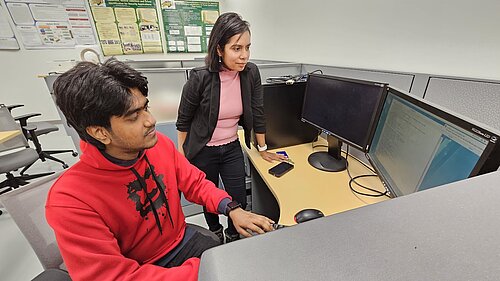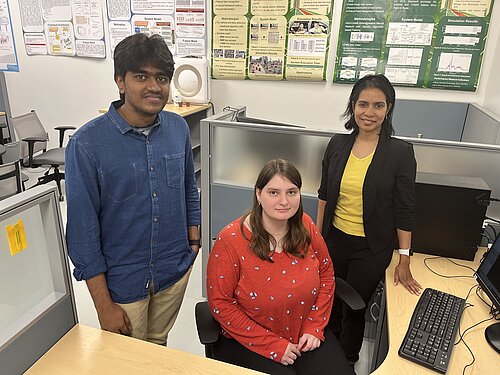NDSU researcher looking for new ways to improve computer system efficiency

Sumitha George, NDSU assistant professor of electrical & computer engineering, recently received a National Science Foundation (NSF) grant to study how to increase efficiency of computer systems having multi-level cell (MLC) storage, which can store more than one bit of information in a single device. The study will investigate the incorporation of emerging technology based designs into existing computer system models. The award will provide $175,000 to George over the next two years.
The large amount of data we generate and consume has been rapidly increasing in recent years given the advent of new technologies like social media, artificial intelligence and the Internet of Things and our computer systems are struggling to keep up. Traditional computer systems are not equipped to handle this massive amount of data and as a result, new approaches to data storage and processing are needed to keep up with the demands of modern computing.
One of George’s interests has been how to optimize memory.
“We have a reached an interesting point in technology where we may not be able to continue shrinking our traditional transistors for increasing system performance,” she said. “We’re now operating at a nanoscale level and even though Moore’s Law told us for decades that the number of transistors on a microchip would double every two years, it has become increasingly difficult to continue this rate due to physical limitations. This means that now we have to start looking for ways to increase the efficiency of computers by creating new forms of transistors and memory cells that function in different and exciting ways.
George is a specialist in very large-scale integration (VLSI) design and computer architecture at NDSU. VLSI design is the process of creating an integrated circuit by combining millions or billions of MOS transistors (the most basic element in the design of a large scale integrated circuits) onto a single chip. She joined the institution in 2020 after receiving a PhD in computer science and engineering at Penn State University. She also spent time at IBM as an R&D engineer and as a research intern at Intel. At NDSU, she teaches and works with students in her lab on ways to create new circuit and architecture designs for computers.
The way our current computing systems work is that data is stored in memory and then needs to be moved to processing units before it can be acted upon and then it goes back to memory for storage. All this action uses a lot of power and adds delay to processing. Compounding the issue is that each memory cell stores only one bit of data, which means that a large number of memory cells are required for a system.
George’s research will look for a new computing design that reduces the amount of data that needs to be moved between memory and processing by creating units that are multi-directional and have the ability to do some of the processing. These new memory units will have a flexible multi-level construction (MLC), which will allow them to function in different ways.
Memories with MLCs will be able to store multiple bits of information instead of just one bit, which means overall, more data will be able to be stored in a smaller area, which is a benefit when large amounts of data need to be stored where space is at a premium. And by giving memory units the opportunity to do some of the processing before moving the data, George also aims to create systems that are faster and more power efficient.

One limitation to MLCs is that converting their data into binary format requires complex circuits. George’s project will use ferroelectric field-effect transistors (FeFETs) for this conversion. While not yet commonly used in commercial computing systems, there is much growing interest in the potential of FeFETs as an emerging technology because they are a type of transistor that can retain data without needing power and they possess flexibility to program their threshold voltage -- both traits that make them useful in memory and logic applications. George believes that as FeFET technology continues to improve and mature, it will become more common in computing systems.
George’s approach and work has the potential to greatly improve the efficiency and flexibility of computing systems, which will allow them to better handle the increasing amounts of data that we generate and process in our daily lives.
With the award, she hopes to hire two graduate students for her lab. She has also been recruiting and adding undergraduate students to her program. “Given my industry experience, I try to bridge the gap between what students learn at school and what is needed and expected in the workforce,” she said. “I also try to connect my students with my colleagues in the field to ensure they are best prepared to succeed after graduation.”“Preparing students to make contributions in important areas like computer architecture is one way in which the NDSU College of Engineering is building tomorrow’s workforce,” said NDSU President David Cook. “Faculty researchers with industry experience like Dr. George provide our students with unique perspectives that prepare them to succeed when they graduate.”
For more information about this award, see CRII: FET: Ferroelectric FET based flexible circuits and system design


